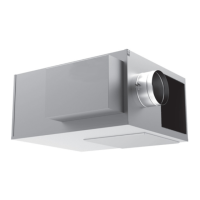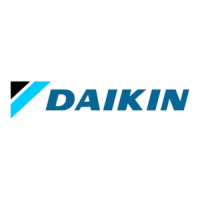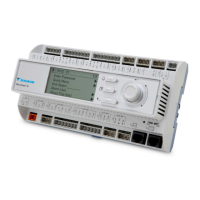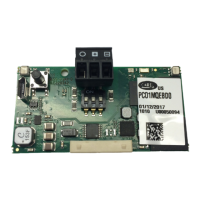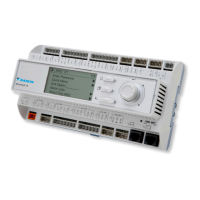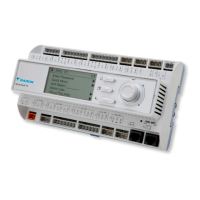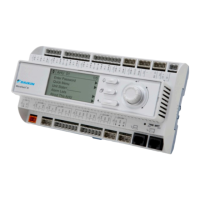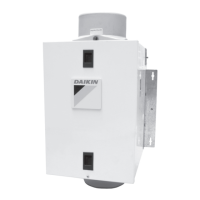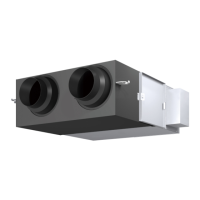www.DaikinApplied.com 17 OM 1280-2 • MICROTECH UNIT CONTROLLER
End-Of-Cycle Valve Interlock with Low
Outside Air Temperature
If the OA temperature is less than or equal to 34°F (default,
adjustable) and the F&BP damper is in the full bypass position,
regardless of room temperature. Once de-energized due to OA
used to again allow the EOC valve to be energized.
Defrost State – Air-Source Heat Pump Only
The Defrost state is a “normal” state that the UVC can go into
while heat mode is active.
When defrost is required, the UVC uses active defrost by
placing the reversing valve into cooling mode for 1 minute
(default) during which the unit’s electric heaters are used for
any space heating requirements. See Figure 11 on page 19
When the unit’s evaporator temperature (outdoor coil during
heating) becomes equal to or less than the defrost setpoint,
and the compressor has been running heating for longer than
the Defrost Check Time the unit active defrost begins. When
active defrost begins, the OA fan de-energizes, the compressor
is commanded to stage 2, and the reversing valve switches
to the cooling mode and the OA fan remains de-energized
until the outdoor coil temperature (condenser) rises above the
When the Defrost state becomes active, the UVC will use
secondary heat (electric heat) as needed to maintain the current
DATS will not be allowed to go above DAHL. The CO
2
demand
controlled ventilation function will be active, if the unit is equipped
for CO
2
control (see ”CO
2
Demand Controlled Ventilation
(optional)” on page 37), and the OA damper will be adjusted
as needed to maintain the CO
2
setpoint. The UVC will remain in
this state until one of the transition out conditions become true, or
until one of the super state transition out conditions becomes true.
Defrost State – Water Source Heat Pump
Only
The Defrost state is a “normal” state that the UVC can go into
while Heat mode is active.
WSHP UV will be allowed to enter the defrost mode twice
in a 7 day period, and upon entering the defrost mode a 3rd
time in that 7 day period, it will be locked out on a low suction
temperature alarm and require a manual reset to resume
operation. See Figure 11 on page 19
When defrost is required, the UVC uses active defrost by
placing the reversing valve into cooling mode for 1 minute
(default) during which the unit’s electric heaters are used for
any space heating requirements.
When the unit’s suction refrigerant temperature becomes
equal to or less than the Low Suction Line Temperature
setpoint, active defrost begins. When active defrost begins,
the compressor is commanded to stage 2, and the reversing
valve switches to the cooling mode until the suction refrigerant
temperature rises above the Low Suction Line Temperature
state becomes active, if available the UVC will use secondary
heat (electric heat) as needed to maintain the current DATS.
The DATS will not be allowed to go above DAHL. The CO
2
demand controlled ventilation function will be active, if the
unit is equipped for CO
2
control (see ”CO
2
Demand Controlled
Ventilation (optional)” on page 37), and the OA damper will
be adjusted as needed to maintain the CO
2
setpoint. The UVC
will remain in this state until one of the transition out conditions
become true, or until one of the super state transition out
conditions becomes true. If the suction temperature is below
the low suction temperature setpoint (default 28ºF) after the
defrost timer has expired, the unit will exit defrost mode and
display Low Suction Temp Alarm.
Low Limit State
The Low Limit state is a “non-normal” state the UVC can go
into while Heat mode is active when the unit reaches 100%
heating and still cannot meet the VCLL. This is likely to
occur only if the OA temperature is very cold, the OA damper
minimum position is set too high, the unit ventilator is oversized
for the application, or if the heating has failed, or is set
incorrectly.
When the Low Limit state becomes active, the heating output
is set to 100% capacity and the Low Limit can override the OA
damper position (see ”Outdoor Air Damper Operation” on page
35) and adjust the OA damper toward closed as necessary
to maintain the VCLL.
